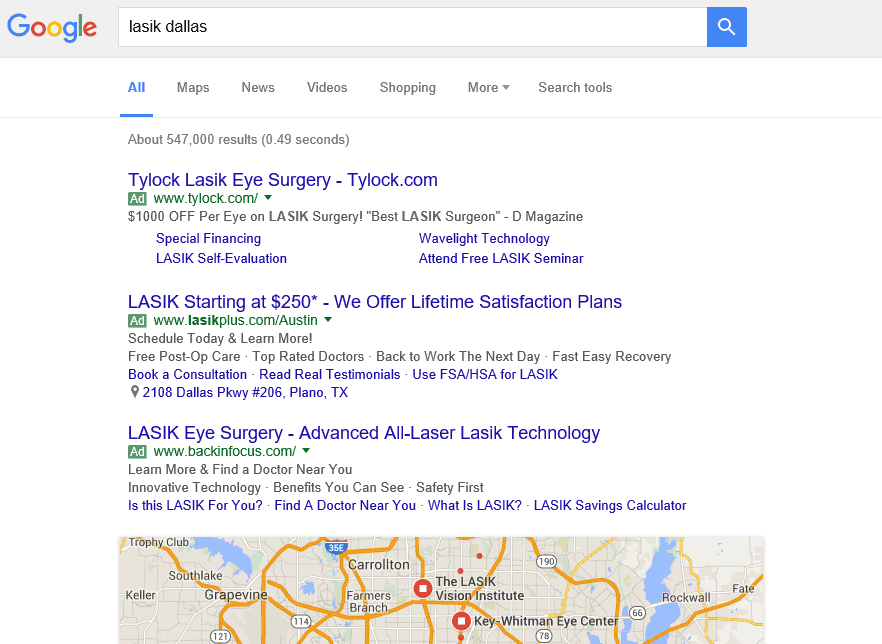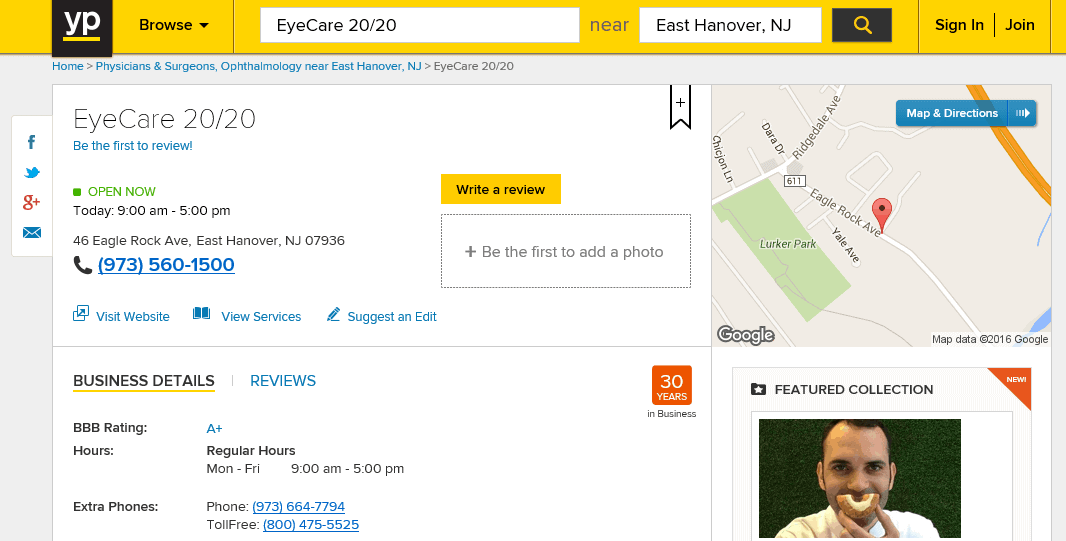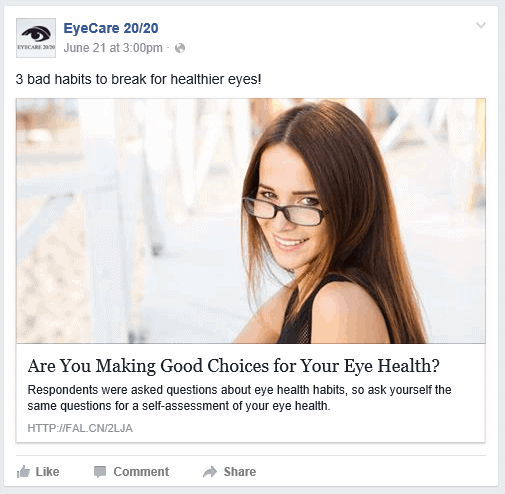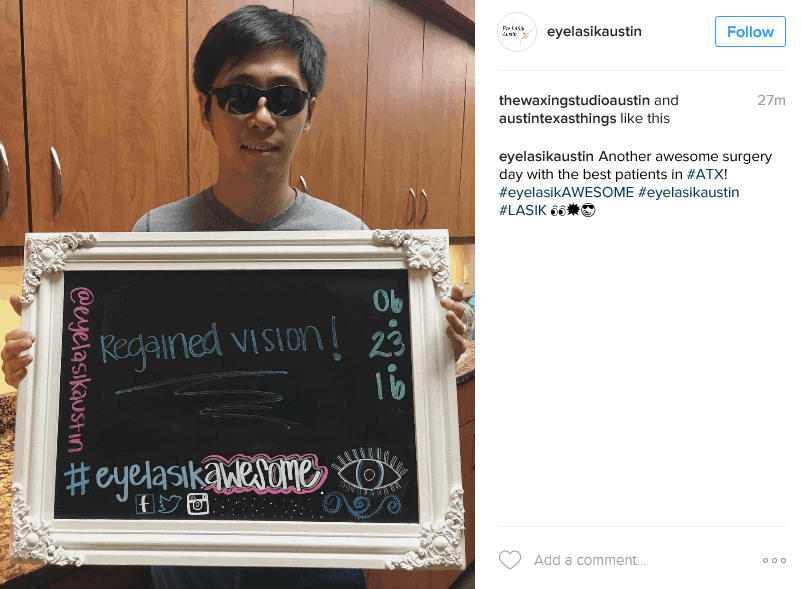As an ophthalmologist, you’re facing a lot of unique challenges.
LASIK surgery is more popular than ever before – which means you’re up against more competition than ever before.
And with so many people getting LASIK every day, your pool of potential patients is steadily growing smaller.
Of course, LASIK isn’t all you do – from cataract surgery to glaucoma treatments, you offer 360-degree eye and vision care.
But with the constant changes in healthcare coverage, and the ups and downs of the economy affecting how people spend their money, it’s difficult to know how best to attract patients to your practice consistently.
How can you stand out from the competition, and make sure that when people in your area think laser eye surgery, they think of your office?
Imagine you’re a typical patient, thinking about getting LASIK or another eye surgery. What would your first steps be? You’d go online, of course, and do some research. You’d probably read up on the procedure on an informational health website or two, do a Google search for practices in your area, check out their websites and social media pages, and then look up patient reviews on a couple different sites.
Marketing your ophthalmologist practice online is hands-down the best way to get in front of potential patients – but you have to know what you’re doing in order to be effective.
To that end, here is our complete guide to marketing your ophthalmologist practice online. These are the same marketing strategies and tactics that we’ve used successfully with our own ophthalmologist clients over the years, so we know firsthand how well they work. By systematically optimizing your online presence in each of the following categories, you’ll eventually become the go-to ophthalmologist in your area, and attract a steady stream of patients to your practice.
Local Marketing Powerhouse: PPC Advertising
Pay Per Click Advertising can seem intimidating to the uninitiated, but it’s without a doubt THE most effective tool for getting your ophthalmologist practice seen by the right eyes online – the secret weapon in your marketing battle plan!
PPC allows you to reach prospective local patients right at the moment when they’re most receptive to your message – as they’re on Google searching for the services you provide. And rather than hoping that your website shows up in their search results on its own, PPC ensures that it’s right there at the top of the screen, front and center, getting seen.

How does it work? Once you register for an account, Google Adwords provides free tools that allow you to research which keywords and phrases people are using most often to search for your services. This is vital information, since you might imagine that, for example, people would be searching for “cataract surgery,” when actually they’re searching for “cataract removal” or “help for cataracts.” These tools will guide you to choose the most effective keywords to focus on in your ad.
It’s also important to choose keywords that reflect your specific market niche. For example, you don’t want to attract traffic that’s looking for an optometrist as opposed to an ophthalmologist, so you wouldn’t want to target keywords such as “glasses” or “contacts.” Target your specific audience as narrowly as possible to get the most out of your PPC ad.
Once you know which keywords to use, you’ll start the process of creating your PPC ad. You’ll choose the keywords you want your ad to be associated with, so that when a prospective patient searches for that phrase or a similar one, your ad is one of the ones displayed.
Now, here’s where it can get a little complicated. You’re most likely not the only ophthalmologist in your area, so there are probably others trying to get their PPC ads to show up when those same keywords are being searched for, too. Because of this, Google uses a bidding process to decide whose ads get displayed. For each keyword you associate with your ad, you’ll give Google the price range you’re willing to pay in order to get that ad in front of your audience. Depending on the amount of competition for a given keyword, you may end up having to pay more to have your ads show up. But luckily, Google allows you to set a budget for the maximum amount you want to spend, so you can keep the cost under control.
With the keywords chosen, it’s time to write your ad. You’ll have to keep it short and sweet, so make every word count. Your headline should be compelling, mentioning a special deal or making an emotional appeal. The body of your ad should give a few relevant details and call readers to action, whether to visit your site for more information or book a consultation. And the ad should link to a specially created landing page on your website geared solely towards getting visitors to share their contact information – NOT just to your homepage.
Finally, you’ll want to be sure you’re targeting the right audience with your PPC ad. How far are your patients usually willing to drive to have you treat them? Set your ad to display only for people within that distance from your practice, so you’re not wasting money on people too far away to visit.
With your first ad in place, you’ll need to track its performance through Google Adwords. As your campaign runs, you can make tweaks and adjustments to experiment with different ad copy and different keywords, to see what works best.
Of course, your best method of tracking your ad’s effectiveness will be the looking at the number of people who fill out the contact form on your landing page. This will give you a brand new pool of warm, high-quality leads to contact about the services you provide – which will inevitably lead to more patients.
Complete Your Presence on Google Through Strategic SEO
While PPC is without question one of the most effective online marketing methods out there, it’s far from the only one, and it works best when supported by a strong showing on other platforms, as well.
Search engine optimization, for instance, is another vital component of any marketing battle plan. Nothing says brand credibility more than a PPC ad at the top of a search engine results page…and an “organic,” or regular, listing underneath. A ranking like this suggests that your practice has enough quality, expert content on its website to be a serious resource for those looking for information on laser eye surgeries and other services you offer, and that it is established enough, visited enough, and trusted enough to be ranked highly by Google.
But generic SEO practices won’t cut it for a local business like an ophthalmologist practice. You need specialized, targeted SEO aimed at people in your area, not anyone nationwide who happens to be searching for info on LASIK. To achieve this, there are several things you’ll need to do:
1. Optimize your website for local search.
You want your website to show up when people in your area search for services you provide, such as LASIK or cataract surgery. So your website needs to contain SEO keywords like LASIK and cataract surgery, of course – but that’s not all. You also need to be sure and include mentions of your location all over your site, to let Google know that this information is only really relevant to those near you.
Create a dedicated Contact Us page with your location and contact information, but don’t stop there. Put your address and phone number in the footer of every page on your site. Include your location and contact info in your website copy as you describe your services, and mention different nearby cities by name where potential patients might come from. If you sponsor a local sports team, or take part in local events, be sure to talk about that, as well. The more localized keywords you can include on your website, the more Google will understand who your target audience is.
2. Create location-specific content in a blog.
Writing a blog is an important way to continually update your website with fresh, unique content, which Google loves to reward – but be sure to target your blog content to your local audience, as well. Mention your area by name often in your posts, and talk about local events, people, and even local customs that will show Google – and potential patients – just how much a part of your local community you are.
You can even take it a step further and make it personal. Post testimonials that your patients provide, mentioning them, where they live, and where they work by name. Interview local experts or local celebrities. Give region-specific eye care tips to your audience, or offer city-specific specials on treatments. The more you reference your area, what goes on there, and the people who live there, the better.
3. Build “citations” on every relevant platform.
Google doesn’t just rely on your own website to get its information – it looks at multiple sources to determine a ranking. So it’s important to have your ophthalmologist practice’s location listed on every relevant local listing site, from YellowPages.com to your local Chamber of Commerce site to Google Local.

4. Focus on reviews.
Finally, reviews from patients are another essential component to optimizing local SEO, since the unfiltered words of actual local patients lend a great deal of credibility to your practice and its presence in your community. Remind every patient to leave you an honest review, since often it doesn’t even occur to people unless they have a negative experience.
Using these targeted local SEO practices, you’ll be able to rank much higher when people from your neighborhood start looking into laser eye surgery, and all the other services you provide.
Get in Touch With Email Marketing
So now your website is trucking along, ranking in local searches and attracting visitors, and your PPC ads are bringing a steady stream of leads to fill out your contact form. What now?
Start an email marketing program!
Email is one of the best ways to market online, because it grants you access to each individual patient or prospective patient’s email inbox. You don’t have to wait for them to come to you – you get to go to them, whenever you want.
One of the main goals of your website should be to gather the email addresses of every visitor, so that you can send them periodic emails with helpful eye care information, specials and deals, and other content meant to keep you top of mind for them.
How can you do this?
Well, your PPC ads should already be bringing in contact information, so you’ve already got a head start on an email subscriber list there. But what about organic visitors to your site? For them, you’ll want to offer something valuable to entice them to give you their email address – a free ebook entitled, “Everything You Ever Wanted To Know About LASIK,” for example, or a free report on “How To Choose the Right Eye Surgeon For You.”
Once you’ve gotten those email addresses, you should send out emails on a regular basis – once a week, maybe, or once a month. These emails should definitely include sales-related information, especially if you have a LASIK special running – but that shouldn’t be all they talk about; otherwise, they won’t be read unless your potential patient is actively looking into having LASIK done soon. Instead, they should include general eye care tips, fun details about staff members, and any info about local events you’ll be taking part in or sponsoring. They can feature patients, or even share your favorite recipes! Anything to make them interesting and inviting, so people read them for fun – and keep you top of mind at any given time.
Engage With Your Community on Social Media
Why would anyone check out posts from an ophthalmologist’s office on Facebook? you may be asking. But you might just be surprised at how many people visit a practice’s social media pages to look for reviews, contact information, specials, and even just community involvement and personality. A Facebook page full of life and activity will always come out on top when compared to one that hasn’t been updated for months – or even worse, no page at all. You don’t need a presence on every single social media platform out there – pick two or three to focus on, like Facebook, Instagram, and LinkedIn, for example, and make your presence vibrant there.
1. Facebook
Everyone is on Facebook, so it pays to jump on the bandwagon. Be sure to fill out your profile completely, as many people use Facebook as a search engine to locate businesses and doctor’s offices and find their contact information and hours of operation. Create an attractive cover photo for your page, and commit to posting regularly. It doesn’t have to be all you, though – ask patients to share photos of themselves celebrating their newly restored vision after surgery, or to talk about their experience at your office.
Whatever you do, don’t come across as overly salesy in your posts – Facebook is much more about creating relationships and brand awareness than it is about making a hard sell to new patients. Share eye care tips, or helpful information about common eye issues.

Talk about local events your staff has taken part in, or upcoming ones you plan to attend or sponsor. Give shout-outs to your patients and their kids for accomplishments or milestones. Make it all about your audience, not about your practice, and it will attract more leads, and ingratiate you with existing patients.
2. Instagram
What could an ophthalmologist’s office possibly have to share on Instagram? How about pictures of patients post-LASIK, squinting and smiling big?

Or how about behind-the-scenes shots of your staff, during surgery, celebrating a birthday, or volunteering at a community event? You could share pics of your staff’s pets…their kids…the amazing batch of cupcakes your office manager baked and brought in to share. And you could ask patients to send you their own pictures to share – ‘best places to watch a sunset from after LASIK surgery,’ or ‘things I can do again now that I had cataract surgery.’ The more potential patients see your practice’s personality and the enthusiastic support of your community of existing patients, the more they’ll want to become a part of that group.
3. LinkedIn
Now, LinkedIn may not necessarily be the place to find patients – but it’s the perfect place to make a name for yourself within the eye care professional community. Why does that matter?
How many referrals do you get from optometrists and opticians currently?
By reaching out to local eye care professionals who do not have the ability to perform surgery, you can become the go-to ophthalmologist they think of first when their patient needs more help than they can provide. By joining LinkedIn Groups related to their field, and then engaging helpfully in their group discussions whenever relevant, you can build a reputation and a relationship with them that will eventually lead them to refer patients to you. The key is to be genuinely helpful in answering questions and contributing to conversations, and avoid seeming salesy or pushy in any way.
Social media is also a great place to show off your technology chops. As an ophthalmologist, you are pretty much always on the cutting-edge of laser technology – why not show off how forward-thinking and modern your practice is by making use of the latest and greatest in social media tech, too? You could take videos of procedures and make Hyperlapse videos to give a quick overview of how it works, or share a few second-long Vine video of someone pranking you in your office. Stream a live feed on Facebook while giving a presentation at a conference, or during the last inning of your annual office team baseball game. The more you demonstrate to patients how much you value new technology, the more they’ll trust you to take care of their eyes.
Pump Up Your Social Media Marketing With Paid Advertising
Just like PPC ads, paid social media ads can seem a little complex at first, but they’re also extremely effective at bringing in leads, because they can target certain groups of people so narrowly. Facebook is especially strong in this area, allowing you to choose who will see your ads based on location, age, gender, demographics, and even interests. You could easily target college students in your area with a “Back-to-School with LASIK” ad campaign, or local moms with a “Chase your kids without worrying about glasses or contacts” campaign. You could also target eye care professionals such as optometrists and opticians with an ad campaign offering incentives for referrals.
Harness the Power of Celebrity With Influencer Marketing
Finally, why not try the hottest trend in online marketing right now – influencer marketing? Contact a local celebrity – or even someone more famous! – and offer them free or discounted LASIK if they share their experience with their social media followers and let them know about your practice. It can be an investment that pays off in spades, if that person has enough of a following online. Word of mouth is still the best way to get new patients in the door, and people trust the opinions of their favorite mommy bloggers, fitness bloggers, industry bloggers, and even local news anchors and other prominent figures as they would a friend’s.
Granted, putting each and every one of these marketing strategies into action is not easy, and it’s not quick. But putting in that time and effort really does pay off in the form of new patients. When you’re up against a huge amount of fierce competition, you’ve got to make your practice stand out through aggressive branding, and taking the above steps will do just that.
If you want all the benefits of this type of marketing, but just don’t have the time or the resources to do it yourself, then please drop us here at Zen Media a line today. Fill out the contact form above to get in touch. We’d be more than happy to help you stand out from the competition, just like we’ve helped our many other clients. Contact us today to chat about your needs and how we can help.







